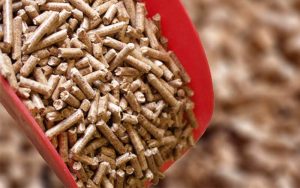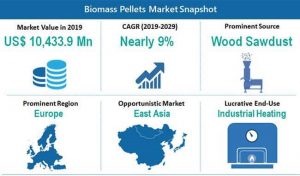Pellet fuel is a renewable, clean-burning and cost-stable home heating alternative currently used throughout North America. It is a biomass product made of renewable substances – generally recycled wood waste. There are approximately 1,000,000 homes in the U.S. using wood pellets for heat, in freestanding stoves, fireplace inserts, furnaces, and boilers. Pellet fuel for heating can also be found in such large-scale environments as schools and prisons. North American pellets are produced in manufacturing facilities in Canada and the United States and are available for purchase at fireplace dealers, nurseries, building supply stores, feed and garden supply stores, and some discount merchandisers. In short, pellet fuel is a way to divert millions of tons of waste from landfills and turn it into energy.
Related Projects:- Waste Management and Recycling, Industrial Waste Management, Agro Waste, Municipal Garbage, Plastic, Paper, Metal, Iron, Glass, Rubber, Electronic, Medical Waste Recycling, Solid Waste Treatment, Agricultural, Wood Waste, Residue Processing Projects

Tea Waste and Rice Husk Biomass Pellet Potentials:
Many pellet manufacturers take by-products (like a wood waste) and refine them into pencil-sized pellets that are uniform in size, shape, moisture, density and energy content. Raw biomass cannot be burnt simply because first, the moisture content of pellets is substantially lower (4% to 8% water–compared to 20% to 60% for raw biomass). Less moisture means higher BTU value and easier handling especially in freezing situations with green raw biomass materials. Second, the density of pellet fuel is substantially higher than raw biomass (40 lbs. per cubic foot versus 10-25 lbs. per cubic foot in raw material form). More fuel can be transported in a given truck space, and more energy can be stored at your site. Third, pellets are more easily and predictably handled. Their uniform shape and size allow for a smaller and simpler feed system that reduces costs. This high density and uniform shape can be stored in standard silos, transported in rail cars and delivered in truck containers.
Related Books:- Modern Technology of Waste Management: Pollution Control, Recycling, Treatment & Utilization
Tea waste (TW) and Rice Husk are some of the biomass resources in Malaysia. Both biomass has the great potential of a bioenergy resource due to its natural properties such as good calorific value, etc. The usage of biomass pellets creates new market opportunities in the agricultural sector and it will reduce the depended on fossil fuels. Thus, in this study, the fuel pellet was prepared by mixing both local TW and EFB fibers. The effect of different types of biomass on the pellet properties was investigated. Properties of raw fibers and fuel pellets were characterized by different analysis method. Pellet made from 100% TW showed the highest calorific value (17.393 MJ/kg), durability index (99.93%) and good pellet moisture content (9.581%). The results show the TW has the great potential to be a good resource for fuel pellets.
Market Demand of Biomass Pellet:
Biomass pellets can be produced from various sources such as timber industry, sawdust, woody plants, switch grass, and sugarcane crop, and commonly used as a heating fuel. The growing use of these pellets in power industry is impacting positively the growth of the biomass pellet market. Also, the rise in demand for renewable energy source is another important factor, which supports the adoption of these pellets in the power industry.
Related Videos:- Waste Management, Waste Recycling, Waste Treatment & Waste disposal methods

Based on the application, in 2014, the market demand of the heat sector stood at 14,256.0 million tons consumption volume, and is anticipated to reach 27,122.3 million tons by 2020, with a CAGR of 8.7% during the forecast period. In addition, the power sector is expected to witness the higher growth rate (12.4% CAGR) in the forecast period, in the global market.
Conclusion:
NPCS has made a project report on “Biomass pellet” the report covers all the important aspects of business such as analyzing the market, confirming availability of various necessities such as plant & machinery, raw materials to forecasting the financial requirements. You can get this project report from the official website of NPCS.
Noo_Art2021
#DetailedProjectReport #businessconsultant #BusinessPlan #feasibilityReport #NPCS #industrialproject #entrepreneurindia #startupbusiness #BusinessIdeas #StartupBusinessIdeas #BusinessOpportunity #TeaWaste #WasteManagement #WasteManagementProject #wastemanagementindustry